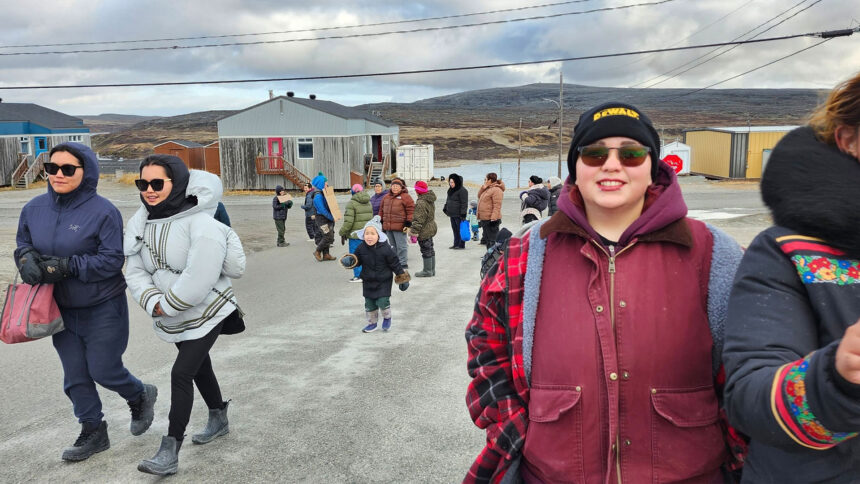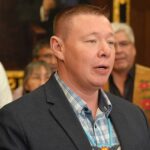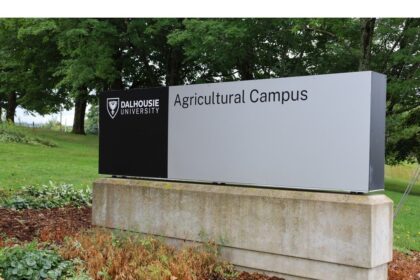When Olivia Ikey and Suzy Kauki decided in August to hold a march of remembrance for Inuit lost to police shootings, they were planning a single event in Salluit. They didn’t expect it would spread to the majority of Nunavik communities across the northernmost border of Quebec. “Suzy and I had an idea,” Ikey told APTN News. “We did this with not a single cent. I created posters and media posts and we reached out to people in our communities.” She says 11 out of 14 Nunavik communities joined in the march on Nov. 4. “Some of them didn’t have official organizers. Some of them didn’t have people to lead, but they still walked anyway. People just took the time to do it. We were very grateful to see communities all across Nunavik just walk for justice.” The two conceived of the idea for a march to commemorate the one-year anniversary of a Nunavik Police Service (NPS) shooting in Salluit that killed Joshua Papigatuk and wounded his twin brother Garnet, both 26, on Nov. 4, 2024. Since that time, the NPS has been involved in two other fatal shootings. In May, NPS officers shot and killed Mark Annanack, 36, in Kangiqsualujjuaq and in July, NPS officers shot and killed Jamie Kavik, 34, in Inukuak. “We’ve lost three people in the last year, but we’ve also lost 17 people in eight years,” Kauki told APTN. Beyond remembrance, the goal of the march was to encourage people to sign a petition circulated by a lawyer representing Garnet Papigatuk and the Annanack family. That petition calls for the NPS to be disarmed of lethal weapons, as well as for a commission of inquiry into police-involved deaths in Nunavik between 2005 and 2025 and the creation of a $250-million provincial reconciliation team to build bridges between Nunavimmiut and Quebec. Nunavik is an Inuit region made up of 14 communities in sub-Arctic Quebec. The area stretches from the James Bay coast to the border with Labrador. The worst thing, for Kauki, is that she knew Joshua Papigatuk, and she believes if NPS in Salluit—a community of roughly 1,600 people—had known him as well, they would have held their fire. “If they knew who he was, they would have already known that he’s not a dangerous man,” she said. “He is not a killer and he was not armed. It would have been easier for a police officer who knew him to de-escalate the situation. But in this particular event, that night November 4 2025, these two officers were new. They did not know the community.” Both Kauki and Ikey see this lack of familiarity—not just with community members, but also with Inuit culture and Inuktitut—as deadly. The overwhelming majority of NPS officers are not Inuit and come from southern communities. Ikey notes that a coroner’s report following a fatal NPS shooting in Umiujaq in 2017 called for an Inuk officer in every community served by the NPS, as well as an officer with a minimum of five years’ experience. “This doesn’t seem to be happening,” Ikey said. Read more: 34-year-old man killed in police shooting in Inukjuak: family People take to the streets in Montreal to protest shooting of Papigatuk twins She noted another conclusion of the coroner’s report from the 2017 shooting was the need for better training, but said currently the cultural training non-Indigenous NPS officers receive before deploying to Nunavik is a 12-hour online workshop from Laval University taught by non-Inuit. “They’re not even being trained about Inuit realities by an Inuk,” Ikey said. Kauki noted the challenge posed by the fact that many organizations will only accept accredited training given by a university. There is virtually no such training designed and administered by Inuit. “In our minds, the cultural training should be given by the people of the territory they’re going to be serving and protecting,” Kauki said. She and Ikey have each developed cultural-awareness programs for non-Indigenous police in Nunavik, and they feel either workshop could help train officers to better understand the society they are entering when they move north. “But unfortunately, organizations are looking at more quote-unquote formal training, and that is not necessarily what we’re asking when it comes to cultural sensitivity.” Rather than increasing training, Inuit officers and experienced police, Kauki said NPS officers have got increased firepower. Not only do they carry Glock 17 pistols on their waists, but they are often seen responding to calls in various Nunavik communities carrying semi-automatic assault weapons. An NPS officer carries a semi-automatic firearm while responding to a false report of an active shooter in Inukjuak on July 19. Photo by Annie Williams “[These guns] are extremely massive, they’re extremely intimidating,” she said. “I think they can kill belugas or polar bear. Those are very powerful guns that are now being permitted to be carried around.” Ikey said that while gathering petition signatures this week at the Co-op in Salluit, she was approached by a woman who told her it was impossible to take guns away from police. Ikey agreed. “We’re a hunting nation,” she said. “We have guns in every single home. So we understand that guns are needed. But at what cost? Back in the day, when we were children, police officers had guns in their patrol vehicle that were locked up. If it was necessary, they had to think properly to be able to go get that gun. Now, it’s on their waist. It’s such a fast thing they can grab.” Ikey said she’d prefer that police be trained in de-escalation rather than resorting quickly to lethal force. Yet it’s hard for police officers who speak French and English to de-escalate crises occurring in Inuktitut, facing people whose ways of thinking and of being are foreign. “They’re unable to de-escalate because they don’t even know how to talk to us, period,” Ikey said. The fact that Nunavik’s history with police has been so painful doesn’t make that any easier. “At first, they were taking our children to go to residential schools,” Ikey said. “And then they slaughtered our dogs to make sure we stopped moving. This relationship with police has been a hurtful relationship since the beginning. So we’re not only fighting for right now, but we’re fighting for the past, [for] our ancestors who were treated poorly by police officers. This is the legacy of police treatment that we’re trying to dismantle.” Another issue, said Kauki, is the disconnect between traditional approaches to Inuit justice and the model of policing in Nunavik communities. “Inuit justice was all about social harmony, about loving one another, keeping everybody safe,” Kauki said. “Especially in the harsh conditions that they were faced with.” She gave the example of a couple who are parents and often have raging fights. In the modern system, they would be separated by police and told not to see one another, or legally restrained from doing so. “In our culture, it would be the opposite,” she said. “If a couple is in this kind of situation, the community would work on them together. There would be members in the community that would give them training and advice on how to be a better relationship and how to live with each other in harmony and respect. The family would be taken out on the land, or the family would be taken into a family discussion where that harmony is trying to be re-established.” Ikey said she finds policing to be an incredibly difficult subject to discuss, because every community has been traumatized by deaths at the hands of NPS. She said that pain makes it hard for everyone to see clearly what she, Kauki, and others advocating for changes are hoping to accomplish. For Ikey, there’s no question of removing police from Nunavik communities and returning wholly to pre-contact forms of justice. Instead, the challenge she, Kauki, and Inuit across Nunavik face is to figure out how to improve relationships between Inuit and police. “We’re not fighting against the individual man under the uniform,” Ikey said. “We’re fighting against the system behind this man with the uniform and how we can improve the reality of this person that will come to serve and protect our community.” To that end, Ikey and Kauki went directly to the NPS detachment in Salluit to introduce themselves and explain the march to the officers. Though Ikey noted the tension was palpable, and some NPS officers were not welcoming, others were very kind. “We wanted to explain to them,” she said, “this is not against police. This is not against you. This is against the system.” The end result was that police in Salluit led the march. “We had a police patrol car in the front with their lights on leading us. And they thanked us! We understand that the police are working under extreme circumstances with little resources, so we wanted to walk with them, for them, and for us.” This level of mutual understanding was not reflected in every community. Kauki said when she visited the NPS detachment in Inukjuak hoping to put a poster for the march on their bulletin board, she was not welcomed warmly. Still, Ikey thinks Inuit communities should try to make connections with the NPS. She also believes it’s important that police understand the legacy of the Inuit-police relationship in the territory. “As Inuit, we need to reach out to the police to say we want to know you as a human being,” she said. “And the police need to stop being scared of us.” Both Ikey and Kauki say the next steps will be the presentation of the petition for change to the provincial government, and they hope to see their aims supported by Kativik Regional Government (KRG). In June, following the Mark Annanack’s death in Kangiqsualujjuaq, the KRG passed a resolution calling for an audit of the NPS, which began in July following the Jamie Kavik’s death in Inukjuak. Kauki and Ikey noted KRG chairperson Maggie Emudluk came to Salluit to participate in the march, which both saw as a positive sign. However, Kauki took issue with the fact that in articles subsequent to the event, KRG representatives refused to comment on the issue of policing. “If you cannot comment on this event,” Kauki said, “just let us know we have your support. That’s all you need to say. You’re a big institution! Let us know that you’re going to keep us safe in this peaceful movement.” Continue Reading
Memorial marches for Inuit killed by police spread to 11 of 14 Nunavik communities

Leave a Comment









